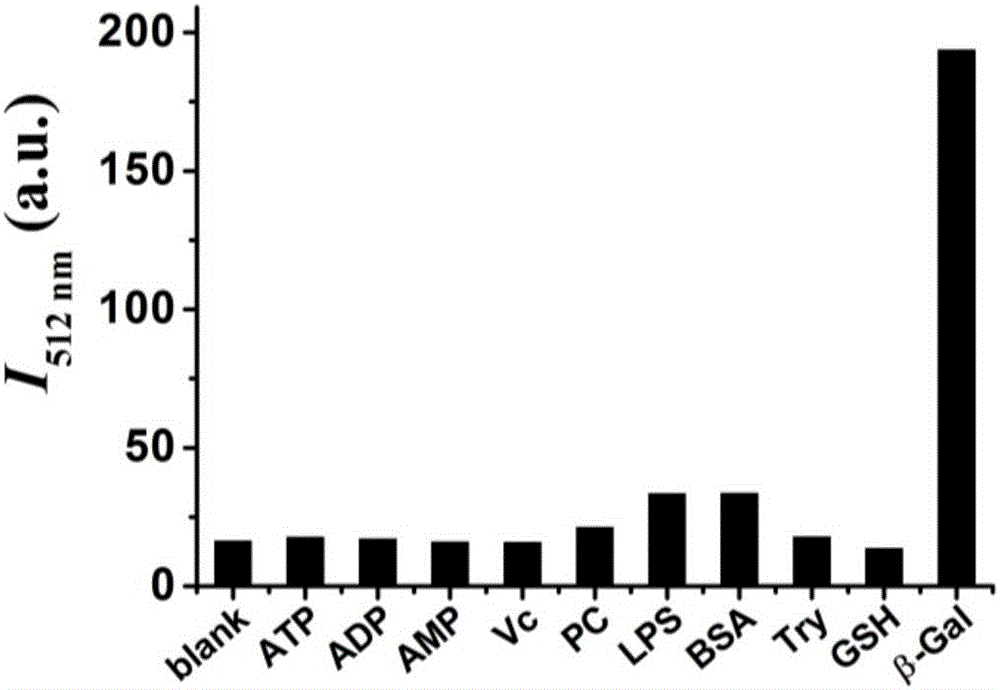Synthesis and applications of beta-galactosidase sensor with aggregation induced emission enhancement performance
A galactosidase and fluorescence sensor technology, which is applied in the field of biochemical materials, can solve the problems of fluorescence quenching, less fluorescence sensors, and limit the practical application of β-galactosidase fluorescence sensors, and achieves easy mass production and Application, simple synthesis steps, overcoming the easy bleaching effect of dye molecules
- Summary
- Abstract
- Description
- Claims
- Application Information
AI Technical Summary
Problems solved by technology
Method used
Image
Examples
Embodiment 1
[0027] Synthesis of target compound 1
[0028]
[0029] (1) Synthesis of compound 2: Zinc powder (1.56g, 24mmol), 4-bromobenzophenone (313mg, 1.2mmol) 4,4'-dimethoxybenzophenone (242mg, 1.0mmol) It was added to anhydrous tetrahydrofuran, and the suspension was cooled to 0°C with stirring. Then titanium tetrachloride (2.276g, 12mmol) was slowly dropped into the mixture with a syringe, and the mixture was refluxed for 4h after stirring at 0°C for 30min. Cool and add sodium carbonate solution dropwise with stirring until no bubbles are produced. Dichloromethane and saturated brine were added for separation and extraction, the organic phase was washed three times with saturated brine, the organic phase was dried over anhydrous sodium sulfate, concentrated, and separated by column chromatography to obtain compound 2 with a yield of 29%. The NMR characterization data are: 1 H NMR (400MHz, CDCl 3 )δ7.21(d,J=4.6Hz,2H),7.20(m,3H),7.00(m,2H),6.95–6.87(m,6H),6.67–6.61(m,4H),3.76(s...
Embodiment 2
[0035] β-galactosidase sensor performance test
[0036] (1) Determination of the response time of the β-galactosidase sensor: Take 20 μL of DMSO solution (1 mM) of compound 1 in 2 mL of PBS buffer solution, add 8.0 U / mL β-galactosidase, and incubate the mixture at 37 °C At different times, the fluorescence intensity of the mixed solution was measured as a function of the incubation time. The results showed that the fluorescence intensity was basically saturated after 10 minutes.
[0037] (2) Fluorescent titration test of β-galactosidase sensor: Take 20 μL of compound 1 in DMSO solution (1 mM) in 2 mL of PBS buffer solution, then add different amounts of β-galactosidase in PBS solution, and mix the solution at 37 ° C After incubation for 10 min, measure the fluorescence emission spectrum (E x =344nm), the fluorescence intensity of the mixed solution presents a good linear relationship in the concentration range of 0.8U / mL to 4.8U / mL β-galactosidase (such as figure 1 shown). ...
Embodiment 3
[0040] Human ovarian cancer cell (OVCAR3) β-galactosidase fluorescence imaging: OVCAR3 cells were revived and inoculated in RPMI 1640 medium containing 10% fetal bovine serum. HeLa cells were revived and inoculated in DEME medium containing 10% fetal bovine serum. Both cells were incubated at 37°C, 5% CO 2 , 100% saturated humidity incubator. Then cultured on 18mm coverslip for 24h, ready to use.
[0041] The two kinds of cells were respectively immersed in the medium containing 5 μM compound 1, at 37 °C, 5% CO 2 After culturing for 40 minutes in an incubator with 100% saturated humidity, pour out the medium, and wash the cells 3 times with fresh medium. Observe under laser confocal fluorescence microscope respectively, and take pictures under bright field and dark field (such as image 3 shown). The results showed that the target compound 1 only showed a strong fluorescent signal in OVCAR3 cells overexpressing β-galactosidase, while under the same conditions, the fluores...
PUM
 Login to View More
Login to View More Abstract
Description
Claims
Application Information
 Login to View More
Login to View More - R&D
- Intellectual Property
- Life Sciences
- Materials
- Tech Scout
- Unparalleled Data Quality
- Higher Quality Content
- 60% Fewer Hallucinations
Browse by: Latest US Patents, China's latest patents, Technical Efficacy Thesaurus, Application Domain, Technology Topic, Popular Technical Reports.
© 2025 PatSnap. All rights reserved.Legal|Privacy policy|Modern Slavery Act Transparency Statement|Sitemap|About US| Contact US: help@patsnap.com



